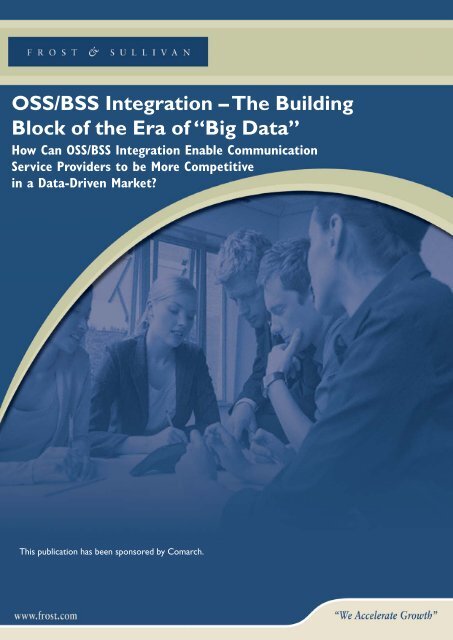OSS/BSS Integration â The Building Block of the ... - Prepaid MVNO
OSS/BSS Integration â The Building Block of the ... - Prepaid MVNO
OSS/BSS Integration â The Building Block of the ... - Prepaid MVNO
You also want an ePaper? Increase the reach of your titles
YUMPU automatically turns print PDFs into web optimized ePapers that Google loves.
<strong>OSS</strong>/<strong>BSS</strong> <strong>Integration</strong> – <strong>The</strong> <strong>Building</strong><br />
<strong>Block</strong> <strong>of</strong> <strong>the</strong> Era <strong>of</strong> “Big Data”<br />
How Can <strong>OSS</strong>/<strong>BSS</strong> <strong>Integration</strong> Enable Communication<br />
Service Providers to be More Competitive<br />
in a Data-Driven Market?<br />
This publication has been sponsored by Comarch.
Table <strong>of</strong> Contents<br />
Fundamental Challenges Faced by CSPs .......................................................................................................3<br />
Intensifying Competition...........................................................................................................................4<br />
Reduced Time-to-Market ..........................................................................................................................4<br />
Customer Experience Issues......................................................................................................................5<br />
Meeting <strong>the</strong> Expectations <strong>of</strong> an Increasingly Demanding User Base........................................................5<br />
Network Congestion..................................................................................................................................5<br />
Dealing with Regulatory Issues .................................................................................................................6<br />
<strong>OSS</strong>/<strong>BSS</strong> Convergence as an Answer to Operator Challenges ......................................................................7<br />
Faster Time-to-Market ..............................................................................................................................8<br />
Support for New Business Models ............................................................................................................9<br />
Improved Flow <strong>of</strong> Information ..................................................................................................................9<br />
Regulated Services Management............................................................................................................10<br />
<strong>OSS</strong>/<strong>BSS</strong> <strong>Integration</strong> – Comarch’s Innovative Approach.............................................................................11<br />
Pre-integrated <strong>OSS</strong> and <strong>BSS</strong> ....................................................................................................................12<br />
Customer-focused <strong>OSS</strong>............................................................................................................................12<br />
Conclusion ...................................................................................................................................................14<br />
About Comarch ...........................................................................................................................................15<br />
About Frost & Sullivan.................................................................................................................................15<br />
© 2010 Frost & Sullivan www.frost.com 2/15
Fundamental Challenges Faced by CSPs<br />
Frost & Sullivan has witnessed <strong>the</strong> telecommunications world change significantly over <strong>the</strong> last ten<br />
years. <strong>The</strong> evolution <strong>of</strong> customer demand, supported by <strong>the</strong> broadband development, has led to <strong>the</strong><br />
emergence <strong>of</strong> new services such as internet television, video on demand and voice over IP.<br />
Customers require more complex, tailored packages with high service quality. As a result,<br />
communication service providers (CSPs) need to place greater focus on <strong>the</strong> overall customer<br />
experience and - given intensifying competition - <strong>the</strong> speed <strong>of</strong> bringing new services to market.<br />
At <strong>the</strong> end <strong>of</strong> 2010, Frost & Sullivan conducted a survey <strong>of</strong> global Tier 1 CSPs. Based on <strong>the</strong> results <strong>of</strong><br />
this research, Figure 1 illustrates <strong>the</strong> most significant challenges currently faced by leading service<br />
providers.<br />
Figure 1: Key CSP Challenges, 2010<br />
Dealing with regulatory issues<br />
7%<br />
Network congestion<br />
13%<br />
Sustaining pr<strong>of</strong>itable growth<br />
Keeping pace with new technology trends<br />
20%<br />
20%<br />
Reducing complexity <strong>of</strong> <strong>the</strong> company's strructure<br />
Reduced time-to-market<br />
30%<br />
30%<br />
Growing customer expectations<br />
Efficiency improvement<br />
37%<br />
40%<br />
Intensifing competition<br />
57%<br />
0% 10% 20% 30% 40% 50% 60%<br />
Source: Frost & Sullivan, 2010<br />
In order to keep pace with market evolution, CSPs have been prompted to redefine <strong>the</strong>ir strategies.<br />
<strong>The</strong> majority have transformed <strong>the</strong>mselves from basic network access providers to service<br />
aggregators, providing network access as a medium for delivering content and o<strong>the</strong>r value-added<br />
services.<br />
<strong>The</strong> implementation <strong>of</strong> new strategies is a lengthy process, requiring <strong>the</strong> engagement <strong>of</strong> a broad<br />
range <strong>of</strong> a service provider’s resources as well as a change <strong>of</strong> mindset and technical improvements:<br />
CSPs need to ensure comprehensive integration <strong>of</strong> <strong>the</strong>ir operational support systems (<strong>OSS</strong>) and <strong>the</strong>ir<br />
business support systems (<strong>BSS</strong>).<br />
© 2010 Frost & Sullivan www.frost.com 3/15
Intensifying Competition<br />
Alongside growing telecom market maturity, <strong>the</strong> competitive environment has become fierce.<br />
Almost 60% <strong>of</strong> CSPs surveyed by Frost & Sullivan in late 2010 stated growing competition as very<br />
important challenge. <strong>The</strong> introduction <strong>of</strong> new IP-based services that can replace traditional<br />
communication and media services has altered <strong>the</strong> competitive landscape. <strong>The</strong> widespread<br />
availability <strong>of</strong> broadband access has enabled <strong>the</strong> emergence <strong>of</strong> numerous over-<strong>the</strong>-top (OTT)<br />
providers that have started to <strong>of</strong>fer innovative services delivered over CSP-owned infrastructure. As a<br />
result, such companies have not been competing with CSPs from a network and operational<br />
perspective, but strictly at <strong>the</strong> service level.<br />
In many cases, <strong>the</strong> services provided by OTT players such as Skype, Google and Facebook are free <strong>of</strong><br />
charge for <strong>the</strong> end-user. However, <strong>the</strong>y <strong>of</strong>ten provide a substitute option, challenging <strong>the</strong> revenue<br />
generating potential <strong>of</strong> CSPs in certain areas. Additionally, some types <strong>of</strong> OTT services, notably online<br />
video services, consume significant bandwidth. To underline this point, in 2010 <strong>the</strong> global data usage<br />
associated with video consumption reached 4 gigabytes per user per month; Frost & Sullivan expects<br />
<strong>the</strong> volume to surge fur<strong>the</strong>r over <strong>the</strong> next five years. Noteworthy is <strong>the</strong> fact that CSPs are responsible<br />
for maintaining and enhancing <strong>the</strong> infrastructure that OTT services rely upon for <strong>the</strong>ir delivery, but<br />
receive no direct revenue in return. This situation has provoked much debate across <strong>the</strong> industry,<br />
with several leading operators voicing <strong>the</strong> opinion that OTT providers should pay <strong>the</strong>ir fair share <strong>of</strong><br />
network upgrade/operational costs.<br />
<strong>The</strong> most important challenge for CSPs is to find appropriate solutions that allow <strong>the</strong>m to compete<br />
with <strong>the</strong> OTT providers on an equal footing. Given <strong>the</strong> specific environments that CSPs and OTT<br />
players operate in, equalizing <strong>the</strong> competitive conditions may not be possible. In this case, <strong>the</strong><br />
alternative may be cooperation between <strong>the</strong> two parties. Thanks to <strong>OSS</strong> and <strong>BSS</strong> unification, CSPs<br />
can provide OTT companies <strong>the</strong> quality assurance <strong>of</strong> <strong>the</strong>ir applications gaining new sources <strong>of</strong><br />
revenues.<br />
Reduced Time-to-Market<br />
Intense competition and rapidly changing customer demand require much more flexibility from CSPs.<br />
Innovation and rapid response to changing competitor strategies <strong>of</strong>ten play a key role in determining<br />
market success. <strong>The</strong> need to reduce time-to-market is an important challenge for 30% <strong>of</strong> <strong>the</strong> CSPs<br />
surveyed by Frost & Sullivan, highlighting <strong>the</strong> need for focus in this regard.<br />
For many CSPs, time-to-market delays are still significant. <strong>The</strong> creation <strong>of</strong> communication services<br />
and testing procedures <strong>of</strong>ten take more than 12 months. Due to network architecture complexity,<br />
<strong>the</strong> implementation <strong>of</strong> new services <strong>of</strong>ten requires <strong>the</strong> deployment an entirely new <strong>OSS</strong>/<strong>BSS</strong> stack.<br />
As a consequence, silos <strong>of</strong> s<strong>of</strong>tware, hardware and staff are created, each having its own associated<br />
operations and maintenance expense burden.<br />
Product creation cycles <strong>of</strong> several months are not sustainable. <strong>The</strong> architecture must allow for<br />
defining, launching, delivering, and withdrawing products in a matter <strong>of</strong> hour or days, ra<strong>the</strong>r than<br />
months. <strong>The</strong> most relevant way to achieve that is to facilitate <strong>the</strong> communication between product<br />
catalogs and network inventory, supporting process automation and significantly reducing time-tomarket.<br />
© 2010 Frost & Sullivan www.frost.com 4/15
Customer Experience Issues<br />
With saturation point reached in many country markets, fur<strong>the</strong>r customer acquisition opportunities<br />
are limited, resulting in customer retention becoming a priority for many CSPs. Many service<br />
providers have been shifting from a network-centric approach to customer-centric one, with <strong>the</strong> aim<br />
<strong>of</strong> improving overall customer satisfaction. Additionally, growing customer expectations are<br />
becoming a more important issue; indeed, this was highlighted as an important challenge by 37% <strong>of</strong><br />
<strong>the</strong> CSPs interviewed by Frost & Sullivan. <strong>The</strong> customer experience does not depend solely on service<br />
quality. <strong>The</strong> information exchange with <strong>the</strong> customer is equally important. Mistakes on invoices,<br />
wrongly targeted marketing messages or poor contact with call centers can all negatively impact<br />
customer experience.<br />
Customers require real-time information related to service availability and <strong>the</strong> actual status <strong>of</strong> an<br />
order. However, due to limited automation <strong>of</strong> information exchange between CRM, Product Catalog<br />
and Resource Inventory, many fixed service providers need several days to verify whe<strong>the</strong>r <strong>the</strong>y have<br />
sufficient infrastructure to provision a particular service in <strong>the</strong> given location. Moreover, real-time<br />
service activation is, in many cases, barely possible. However, solving this issue is becoming a key<br />
priority for CSPs. <strong>The</strong> CSP-focused research conducted by Frost & Sullivan shows that 90% <strong>of</strong><br />
respondents believe real-time activation <strong>of</strong> customer services is critical.<br />
Providing <strong>the</strong> actual status <strong>of</strong> <strong>the</strong> order also causes difficulties for CSPs, while losing orders is<br />
unacceptable. However, once an order passes from customer-oriented systems to network-oriented<br />
systems, most CSPs find it very difficult to link an order back to <strong>the</strong> particular customer. Lack <strong>of</strong><br />
sufficient flow <strong>of</strong> information between <strong>OSS</strong> and <strong>BSS</strong> can cause situations where CSPs start billing<br />
before a service has been activated. <strong>The</strong> customer experience is also harmed by not providing<br />
specific information during network failures.<br />
Meeting <strong>the</strong> Expectations <strong>of</strong> an Increasingly Demanding User Base<br />
<strong>The</strong> quality <strong>of</strong> CSP services has gradually transformed from a best efforts basis into guaranteed<br />
service levels. Increasingly, business customers tend to contractualize <strong>the</strong>ir demands in service level<br />
agreements (SLA) which can be challenging to live up to. Customers want to be protected against<br />
network failures as <strong>the</strong>se can seriously impact <strong>the</strong>ir businesses. In case <strong>of</strong> temporary service<br />
unavailability <strong>the</strong>y want to know exactly when <strong>the</strong>y will have <strong>the</strong> service back.<br />
SLA Monitoring, as an <strong>OSS</strong> element, has become an important tool for increasing customer<br />
satisfaction and reducing losses resulting from SLA complaints. Additionally, integration <strong>of</strong> SLA<br />
Monitoring with CRM has given CSPs <strong>the</strong> opportunity to quickly and easily update changes to a<br />
customer contract.<br />
<strong>OSS</strong> solutions can generate important data about <strong>the</strong> status <strong>of</strong> networks. In <strong>the</strong> event <strong>of</strong> failure, <strong>the</strong>y<br />
can perform advanced diagnostics that generate useful information, for example indentifying <strong>the</strong><br />
location <strong>of</strong> <strong>the</strong> problem and its cause. However, it is still difficult to map this data to <strong>the</strong> affected<br />
customers in order to keep <strong>the</strong>m informed and updated. That is why communication between CRM<br />
and network resources layers plays an important role in proactive fault management.<br />
Network Congestion<br />
<strong>The</strong> success <strong>of</strong> mobile broadband, supported by convenient flat-rate pricing models, has had a<br />
serious impact on network congestion. Many CSPs have limited control over bandwidth<br />
consumption. Thus, limitations are not placed on users regarding streaming or using o<strong>the</strong>r<br />
bandwidth-heavy applications, which can create bottlenecks at peak times. Moreover, <strong>the</strong> significant<br />
growth <strong>of</strong> data traffic has not been compensated by adequate revenue growth.<br />
© 2010 Frost & Sullivan www.frost.com 5/15
Figure 2 shows <strong>the</strong> increasing gap between surging data usage and gradually stagnating CSP revenues<br />
in a data dominated era.<br />
Figure 2: Data Traffic vs. CSP Network Costs and Revenues<br />
Volume<br />
Voice Dominance<br />
Data Dominance<br />
Time<br />
Source: Frost & Sullivan<br />
In order to maintain a high quality <strong>of</strong> mobile broadband services, CSPs have invested heavily in<br />
network upgrades from 2G to 3G and even 4G. This kind <strong>of</strong> investment is characterized by a very long<br />
payback period and by uncertainty that <strong>the</strong> upgraded network will meet <strong>the</strong> requirements <strong>of</strong> surging<br />
data consumption.<br />
CSPs must look for solutions that allow for proper management <strong>of</strong> network congestion which help<br />
<strong>the</strong>m to reduce <strong>the</strong> gap between <strong>the</strong> growing investment costs and flat-rate pricing. This is<br />
particularly important given that CSPs in intense competitive environments are not able to set higher<br />
prices on mobile broadband services. Additionally, going back to usage-based pricing models it is not<br />
an adequate solution as it can discourage service usage.<br />
Frost & Sullivan believes implementing traffic-shaping policies is one <strong>of</strong> <strong>the</strong> best alternatives to<br />
address <strong>the</strong> gap between traffic and revenue. Certainly, many CSPs have written “fair usage” policies<br />
into <strong>the</strong>ir terms and conditions, but when it comes to actually enforcing <strong>the</strong> policies, many are<br />
seriously challenged. Without <strong>OSS</strong>/<strong>BSS</strong> integration, CSPs are not able to successfully carry out policybased<br />
management which allow for more efficient controlling <strong>of</strong> network resources and better<br />
management <strong>of</strong> network congestion.<br />
Dealing with Regulatory Issues<br />
Large CSPs are subject to common carriers obligations and carry a huge regulatory burden. One <strong>of</strong><br />
<strong>the</strong> main goals <strong>of</strong> telecom market regulators has been to support competition in order to ensure low<br />
prices for end-users.<br />
<strong>The</strong> most common method employed to achieve this goal is imposing an obligation on incumbent<br />
CSPs to make <strong>the</strong>ir infrastructure accessible to rival providers. In terms <strong>of</strong> fixed service providers,<br />
© 2010 Frost & Sullivan www.frost.com 6/15
enting <strong>the</strong> last-mile infrastructure from unbundled local loops has become very popular. However,<br />
CSPs face significant problems with <strong>the</strong> flow <strong>of</strong> information between two separate networks, which<br />
results in delays with regards to service activation and difficulties with service fulfillment.<br />
<strong>OSS</strong>/<strong>BSS</strong> Convergence as an Answer to Operator Challenges<br />
Historically, CSPs tend to purchase best-<strong>of</strong>-breed applications for specific functional areas and <strong>the</strong>y<br />
have a long tradition for in-house s<strong>of</strong>tware development. In consequence, many proprietary or highly<br />
customized <strong>OSS</strong>/<strong>BSS</strong> systems remain in operation. This strategy was justified when <strong>the</strong>ir portfolios<br />
only contained a few services. However, with multiple new services and growing complexity <strong>of</strong> <strong>the</strong><br />
CSP architecture, this approach has become untenable.<br />
Mergers and acquisitions have fur<strong>the</strong>r complicated <strong>the</strong> back <strong>of</strong>fice <strong>of</strong> many CSPs. Many providers<br />
have added new systems to <strong>the</strong>ir IT architecture from companies that <strong>the</strong>y had acquired, with only<br />
limited adjustments made. As a consequence, similar services <strong>of</strong>ten rely on very separate IT systems<br />
within a single organization, unnecessarily complicating service fulfillment and increasing costs.<br />
Changing market conditions require <strong>the</strong> breaking down <strong>of</strong> isolated silos <strong>of</strong> s<strong>of</strong>tware designed around<br />
separate technologies or services into horizontally integrated blocks <strong>of</strong> operational and business<br />
support systems that are compatible and able to communicate with each o<strong>the</strong>r. Additionally, in order<br />
to optimize IT costs consolidation <strong>of</strong> systems used for <strong>the</strong> same activities for similar services is<br />
needed.<br />
Figure 3: <strong>OSS</strong>/<strong>BSS</strong> Progression<br />
Best-<strong>of</strong>-Bread<br />
General<br />
Solutions<br />
for Multiple<br />
Providers<br />
End-to-End<br />
Solutions<br />
Common<br />
Processes<br />
Point Solutions<br />
Customized<br />
Processes<br />
Customized<br />
Solutions for<br />
Single<br />
Provider<br />
In-house<br />
Development<br />
Customized<br />
Processes<br />
Best-<strong>of</strong>-Platform<br />
No<br />
<strong>Integration</strong><br />
After-Market<br />
<strong>Integration</strong><br />
Pre-<br />
<strong>Integration</strong><br />
Source: Frost & Sullivan<br />
© 2010 Frost & Sullivan www.frost.com 7/15
Horizontally integrated <strong>OSS</strong>/<strong>BSS</strong> has become a desired solution among CSPs. It is an answer to CSPs<br />
need <strong>of</strong> end-to-end solutions and common processes (see Figure 3). 85% <strong>of</strong> operators interviewed by<br />
Frost & Sullivan prefer commercial <strong>of</strong>f-<strong>the</strong>-shelf solutions (COTS) as opposed to those built in-house<br />
or requiring significant customization. However, many in this group insist on systems that are preintegrated<br />
with o<strong>the</strong>r COTS solutions and that require no special customization for operation within<br />
<strong>the</strong>ir own architecture.<br />
<strong>The</strong> lack <strong>of</strong> integration <strong>of</strong> <strong>OSS</strong> and <strong>BSS</strong> results in limited possibilities for coordination between <strong>the</strong><br />
service design and <strong>the</strong> technical requirements <strong>of</strong> delivering a service. In consequence, <strong>the</strong><br />
implementation <strong>of</strong> a new service is a long, <strong>of</strong>ten manual, process, requiring many operational and<br />
human resources. All CSP representatives interviewed by Frost & Sullivan admitted that existing<br />
fulfillment processes involve too many manual tasks and that, in turn, create too many opportunities<br />
for error.<br />
<strong>The</strong> <strong>OSS</strong>/<strong>BSS</strong> gap also causes problems with regards to appropriate service fulfillment and fault<br />
management. <strong>The</strong> lack <strong>of</strong> proper communication between network facing and customer facing layers<br />
gives <strong>the</strong> CSPs difficulties with providing information about <strong>the</strong> service availability, tracking orders<br />
and identifying customers affected by network failures.<br />
By bridging <strong>the</strong> gap between <strong>OSS</strong> and <strong>BSS</strong>, CSPs can achieve higher process automation, eliminating<br />
<strong>the</strong> need to involve large numbers <strong>of</strong> engineers during implementation and service fulfillment. This<br />
reduces time-to-market and significantly decreases costs. Facilitated communication between <strong>OSS</strong><br />
and <strong>BSS</strong> also supports <strong>the</strong> creation <strong>of</strong> new business and payment models and considerably improves<br />
<strong>the</strong> flow <strong>of</strong> information.<br />
Faster Time-to-Market<br />
One <strong>of</strong> <strong>the</strong> ways to accelerate time-to-market <strong>of</strong> new services is <strong>the</strong> implementation <strong>of</strong> a<br />
component-based product creation environment, supported by ensuring orchestration across<br />
existing <strong>OSS</strong>/<strong>BSS</strong>. Although <strong>the</strong> transformation from existing independent silos <strong>of</strong> <strong>OSS</strong>/<strong>BSS</strong> to a<br />
common platform approach is a long and costly process, it <strong>of</strong>fers CSPs greater flexibility to face<br />
competitive challenges.<br />
<br />
Component-based Architecture<br />
A component-based product creation environment gives CSPs <strong>the</strong> ability to independently<br />
model products, connectivity and even changes using pre-defined components, processes,<br />
rules, and workflows. It alleviates <strong>the</strong> burden <strong>of</strong> testing and adapting all elements. In this way,<br />
products are consistently defined and delivered across <strong>the</strong> business, regardless <strong>of</strong> <strong>the</strong><br />
underlying systems.<br />
<br />
Process Automation<br />
<strong>The</strong> pre-integrated components are made up <strong>of</strong> both <strong>OSS</strong> and <strong>BSS</strong> elements. This means that<br />
services designed in <strong>the</strong> product catalog are automatically mapped onto <strong>the</strong> network<br />
resources. Usage <strong>of</strong> horizontally integrated <strong>OSS</strong>/<strong>BSS</strong> components supports process<br />
automation, simultaneously reducing costs and <strong>the</strong> time needed for integration.<br />
© 2010 Frost & Sullivan www.frost.com 8/15
Support for New Business Models<br />
<strong>OSS</strong>/<strong>BSS</strong> integration allows for creating models that address challenges related to network<br />
congestion and lack <strong>of</strong> sufficient return on investment from network capital expenditures.<br />
<br />
Collaboration Models<br />
In order to compete with OTT providers, CSPs must redefine <strong>the</strong>ir role in <strong>the</strong> IP-based services<br />
value chain. <strong>OSS</strong>/<strong>BSS</strong> convergence supports <strong>the</strong> transformation from simple ‘dumb pipes’ to<br />
complex application enablement, connectivity and quality <strong>of</strong> service (QoS) providers. <strong>The</strong> QoS<br />
component, as a <strong>BSS</strong> element in a product catalog, can be bundled with various applications<br />
and sold to developers, partners or OTT players as a single integrated solution. Thanks to<br />
<strong>BSS</strong>/<strong>OSS</strong> integration, <strong>the</strong> QoS component is also an <strong>OSS</strong> component, focused on shaping traffic<br />
according to QoS definitions and thus enabling to enforce <strong>the</strong> contract between <strong>the</strong><br />
collaborating parties from a network perspective.<br />
<br />
Payment Models<br />
<strong>The</strong> majority <strong>of</strong> traffic within mobile networks is generated by a relatively small proportion <strong>of</strong><br />
users with heavy video-on-demand, gaming or streaming usage. <strong>The</strong>se ‘heavy users’, who pay<br />
<strong>the</strong> same price for mobile broadband, are responsible for network congestion and reducing<br />
<strong>the</strong> quality <strong>of</strong> services for all users. One way to deal with this issue is to split users into ‘heavy’<br />
and ‘basic’ users and introduce tiered pricing plans. By integrating <strong>OSS</strong> and <strong>BSS</strong>, CSPs would be<br />
able to assign defined QoS for various applications based on <strong>the</strong> type <strong>of</strong> user and <strong>the</strong>ir network<br />
requirements. Traffic can be shaped bringing <strong>the</strong> appropriate level <strong>of</strong> QoS according to <strong>the</strong><br />
end-user’s tariff plan.<br />
Improved Flow <strong>of</strong> Information<br />
Appropriate communication between customer- and network-facing layers has a significant impact<br />
on customer experience improvement. It not only facilitates <strong>the</strong> provision <strong>of</strong> real-time information<br />
relating to service availability and order status but also enables proactive fault management.<br />
<br />
Enhanced Customer Relations<br />
Integrated <strong>OSS</strong>/<strong>BSS</strong> gives CSPs a holistic view <strong>of</strong> a customer across <strong>the</strong> whole architecture.<br />
Thus, it allows for correlation and tracking <strong>of</strong> individual services throughout <strong>the</strong> lifecycle. In<br />
consequence, CSPs are able to avoid losing or providing incomplete orders. Moreover,<br />
whenever needed, <strong>the</strong> customer is able to receive necessary information <strong>of</strong> <strong>the</strong> order status or<br />
issues with service fulfillment.<br />
Real-time cost/price calculation is also facilitated by convergent <strong>OSS</strong>/<strong>BSS</strong>. <strong>The</strong> query <strong>of</strong> <strong>the</strong><br />
network resources needed in a particular location is automatically sent to <strong>OSS</strong> and based on<br />
that information; <strong>the</strong> price <strong>of</strong> a service is calculated.<br />
Integrated <strong>OSS</strong>/<strong>BSS</strong> also plays an important role in providing sufficient quality <strong>of</strong> service. <strong>OSS</strong><br />
that carries <strong>the</strong> information <strong>of</strong> <strong>the</strong> status <strong>of</strong> <strong>the</strong> network can translate and automatically sent<br />
reports to CRM systems where <strong>the</strong> network capacity should be increased to improve quality.<br />
© 2010 Frost & Sullivan www.frost.com 9/15
Proactive Fault Management<br />
Unified <strong>OSS</strong> and <strong>BSS</strong> also supports Service Assurance and Service Quality Management. <strong>OSS</strong><br />
automatically sends information regarding a network failure, pointing out <strong>the</strong> locations <strong>of</strong><br />
radio base stations or particular DSL faults. Subsequently, information is translated into<br />
specific addresses <strong>of</strong> <strong>the</strong> customers and is passed onto <strong>the</strong> CRM systems. Thus, CSP call<br />
centers automatically receive <strong>the</strong> information including an overview <strong>of</strong> what <strong>the</strong> problem is<br />
and when a fix is expected. Additionally, <strong>OSS</strong> measures network resource KPIs and<br />
automatically sends notifications to <strong>the</strong> appropriate units within <strong>the</strong> organization so that <strong>the</strong><br />
KPIs can be improved and network failures minimized.<br />
Regulated Services Management<br />
<strong>The</strong> implementation <strong>of</strong> integrated <strong>OSS</strong>/<strong>BSS</strong> can also positively influence <strong>the</strong> management <strong>of</strong><br />
telecommunications services accessed through <strong>the</strong> last-mile infrastructure <strong>of</strong> o<strong>the</strong>r parties. In <strong>the</strong>se<br />
types <strong>of</strong> services, <strong>the</strong> network belonging to <strong>the</strong> third party is treated as an additional <strong>OSS</strong> element.<br />
<strong>The</strong> order is logged on <strong>the</strong> service provider’s CRM system and is <strong>the</strong>n automatically sent to <strong>the</strong> <strong>OSS</strong>.<br />
This <strong>the</strong>n generates <strong>the</strong> query to <strong>the</strong> network operator requesting access to its infrastructure.<br />
Although receiving real-time information depends on <strong>the</strong> third-party architecture, convergent<br />
<strong>OSS</strong>/<strong>BSS</strong> contributes to process facilitation.<br />
© 2010 Frost & Sullivan www.frost.com 10/15
<strong>OSS</strong>/<strong>BSS</strong> <strong>Integration</strong> – Comarch’s Innovative Approach<br />
Comarch’s solution is a good example <strong>of</strong> how <strong>the</strong> gap between <strong>OSS</strong> and <strong>BSS</strong> can be overcome. For<br />
almost 20 years, Comarch has developed, in-house, a large portfolio <strong>of</strong> <strong>OSS</strong> and <strong>BSS</strong> modules which<br />
gives <strong>the</strong> company a comprehensive view <strong>of</strong> both network and service layers. All solutions have been<br />
created with a common technological approach, enabling compatibility and reduction <strong>of</strong> integration<br />
requirements.<br />
With a view to <strong>the</strong> complexity <strong>of</strong> CSP architecture, <strong>the</strong> company ensures flexibility and adaptability <strong>of</strong><br />
<strong>the</strong> systems to existing service provider environments. Comarch uses SID standards defined by <strong>the</strong><br />
TMForum, additionally adjusted to telecom environment. This approach enables <strong>the</strong> reduction <strong>of</strong><br />
costs and risk connected with new component implementation and maintenance, and also facilitates<br />
integration with a CSP’s architecture.<br />
Comarch’s <strong>OSS</strong> and <strong>BSS</strong> solutions are connected via <strong>the</strong> Comarch Enterprise Service Bus (ESB) layer –<br />
<strong>the</strong>refore, <strong>the</strong>y are consistent and communication is simplified. Comarch ESB also serves as a central<br />
communication bus between Comarch’s solutions and third party systems.<br />
Figure 4: Comarch <strong>OSS</strong>/<strong>BSS</strong> <strong>Integration</strong> Between Central Product Management and Service Catalog<br />
Source: Comarch<br />
© 2010 Frost & Sullivan www.frost.com 11/15
<strong>The</strong> Comarch vision <strong>of</strong> integrated <strong>OSS</strong>/<strong>BSS</strong> is realized foremost by providing <strong>the</strong> following solutions:<br />
Pre-integrated <strong>OSS</strong> and <strong>BSS</strong><br />
Comarch’s strategy is to <strong>of</strong>fer both individual modules and pre-integrated solutions, providing CSPs<br />
with a choice between following ei<strong>the</strong>r a best-<strong>of</strong>-breed or best-<strong>of</strong>-platform strategy. Even when a<br />
CSP decides to buy individual modules, Comarch can <strong>of</strong>fer pr<strong>of</strong>essional services to create an<br />
integrated solution. Having pre-integrated solutions in its <strong>of</strong>fer, <strong>the</strong> company guarantees that <strong>the</strong><br />
individual modules are designed and developed to work smoothly in a pre-integrated solution. Frost<br />
& Sullivan believes that Comarch’s core competence is both providing individual modules and<br />
demonstrating how to glue individual <strong>BSS</strong>/<strong>OSS</strong> components (including integration with third party<br />
ones) toge<strong>the</strong>r to bring maximum added value to CSPs’ businesses.<br />
Comarch’s pre-integrated <strong>OSS</strong>/<strong>BSS</strong> components provide CSPs with complex customer, product, and<br />
order lifecycle management solutions to rapidly introduce new <strong>of</strong>ferings and improve <strong>the</strong> customer<br />
experience. <strong>The</strong> company provides an integrated set <strong>of</strong> <strong>of</strong>f-<strong>the</strong>-shelf <strong>OSS</strong>/<strong>BSS</strong> modules to enable<br />
automated business flows when adding functionalities to <strong>the</strong> network. <strong>The</strong> integration between <strong>the</strong><br />
business services configured within <strong>the</strong> Comarch Central Product Catalog (<strong>BSS</strong>) and <strong>the</strong> underlying<br />
network services and resources defined in <strong>the</strong> Comarch Network Inventory and Comarch Service<br />
Inventory (<strong>OSS</strong>) is performed at <strong>the</strong> Customer Facing Services layer. Thus, Customer Facing Services<br />
are a common component <strong>of</strong> both Comarch <strong>BSS</strong> and <strong>OSS</strong>, enabling <strong>the</strong>m to communicate<br />
effectively and granting CSPs a tool to successfully bridge <strong>the</strong> gap between <strong>the</strong> two domains (see<br />
Figure 4).<br />
Direct integration <strong>of</strong> <strong>the</strong> Comarch Central Product Catalog and <strong>the</strong> Comarch Service Catalog<br />
facilitates efficient new service creation. When a new resource is added to <strong>the</strong> Comarch Service<br />
Inventory, it is automatically identified by <strong>the</strong> Comarch Central Product Catalog (CPC) via <strong>the</strong><br />
Customer Facing Service layer. Using <strong>the</strong> Comarch CPC, billing or marketing departments are <strong>the</strong>n<br />
able to design products and <strong>of</strong>fers based on this Customer Facing Service and its capabilities.<br />
Comarch’s solution meets <strong>the</strong> requirement <strong>of</strong> component-based architecture, providing product<br />
managers with readymade puzzles composed <strong>of</strong> <strong>BSS</strong> elements and resources needed to provide <strong>the</strong><br />
service. <strong>The</strong> pre-integrated nature <strong>of</strong> <strong>the</strong> components eliminates <strong>the</strong> need to test new components.<br />
Moreover, thanks to a modular and open architecture, it is easy to fur<strong>the</strong>r develop a CSP’s overall<br />
environment to overcome competitive challenges.<br />
Customer-focused <strong>OSS</strong><br />
Frost & Sullivan believes that Comarch’s concept <strong>of</strong> customer-focused <strong>OSS</strong> aligns well with <strong>the</strong><br />
increasingly customer-centric orientation <strong>of</strong> CSPs. <strong>The</strong> solution primarily aims to enhance customer<br />
value and improve customer experience.<br />
By shifting <strong>the</strong> Resource Facing Services layer to <strong>the</strong> Customer Facing Services layer, all data collected<br />
by systems responsible for Service Fulfillment, Performance Management and Fault Management<br />
(<strong>OSS</strong>) is automatically translated into <strong>the</strong> <strong>BSS</strong> language so it can be read by billing, CRM and o<strong>the</strong>r<br />
<strong>BSS</strong> components. By assuring this communication, CSP customers can receive real-time information<br />
related to service availability and network failures. <strong>The</strong>y can also benefit from real-time service<br />
activation and proactive fault management.<br />
© 2010 Frost & Sullivan www.frost.com 12/15
Comarch’s <strong>OSS</strong> portfolio consists <strong>of</strong> many components shaped by <strong>the</strong> idea <strong>of</strong> customer-focused <strong>OSS</strong>:<br />
<br />
Service Fulfillment<br />
Comarch’s Service Fulfillment solution is deeply integrated within <strong>the</strong> <strong>OSS</strong> space and has a<br />
common element with <strong>BSS</strong>. Thus, it allows CSPs to automate workflow, reduce errors, and<br />
decrease <strong>the</strong> time needed for service activation. <strong>The</strong> solution plays an especially important<br />
role when highly customizable bundles <strong>of</strong> convergent services need to be activated.<br />
With <strong>the</strong> involvement <strong>of</strong> Comarch’s Policy Management, Policy Control and Policy<br />
Enforcement modules (<strong>BSS</strong>), Comarch Service Fulfillment (<strong>OSS</strong>) can support network<br />
congestion management by shaping <strong>the</strong> traffic.<br />
<br />
Performance Management<br />
Comarch Performance Management is a solution enabling complex network quality<br />
management. Due to shifting Performance Management to Service Quality Management<br />
system, technical performance metrics are automatically translated into customer serviceoriented<br />
KQIs. Thanks to <strong>OSS</strong>/<strong>BSS</strong> integration <strong>the</strong> information is transferred in real-time to<br />
<strong>BSS</strong>. Thus, CSPs can quickly react on KPIs that have deteriorated and pro-actively prevent<br />
network failures.<br />
<br />
Fault Management<br />
Comarch Fault Management allows CSPs to effectively control <strong>the</strong> occurrence <strong>of</strong> problems and<br />
faults in <strong>the</strong> entire telecommunications network. Fault Management has been shifted to<br />
Service Assurance systems which enable to measure <strong>the</strong> impact <strong>of</strong> network outages on<br />
customer services. This solution allows for immediate communication between <strong>the</strong> Resource<br />
Facing Services and <strong>BSS</strong>. <strong>The</strong>refore, CSPs can take an action to inform customers about<br />
upcoming breakdowns.<br />
<br />
Customer Experience Management<br />
Comarch Customer Experience Management is a product which provides an insight into end<br />
user perceptions <strong>of</strong> services <strong>of</strong>fered. Thus, it allows CSPs to manage telecommunications<br />
networks and services in a way that enhances customer satisfaction. <strong>Integration</strong> <strong>of</strong> Customer<br />
Experience Management (<strong>OSS</strong>) with <strong>the</strong> CRM system allows verifying <strong>the</strong> computed image <strong>of</strong><br />
customer satisfaction with <strong>the</strong> actual customer opinion <strong>of</strong> <strong>the</strong> service quality, which can be<br />
used in performing analytics needed to properly segment customers.<br />
<br />
SLA Monitoring<br />
Comarch SLA Monitoring allows operators to define and monitor services and related SLAs in a<br />
way that will increases customer satisfaction and minimizes losses resulting from lack <strong>of</strong> SLA<br />
compliance. Comarch SLA Monitoring can be integrated with CRM or sales support solutions,<br />
allowing operators to quickly and easily update changes to a customer contract.<br />
© 2010 Frost & Sullivan www.frost.com 13/15
Conclusion<br />
We have shown that communication service providers world-wide are faced with a number <strong>of</strong><br />
formidable challenges which have emerged as a result <strong>of</strong> increased competition and increasing<br />
demands from both pr<strong>of</strong>essional and residential customers.<br />
We have also shown that <strong>the</strong> drivers behind <strong>the</strong>se challenges have been consistently strong, meaning<br />
that <strong>the</strong> CSP challenges will continue to mount. Many CSPs are already struggling, and <strong>the</strong>ir situation<br />
is likely to get worse.<br />
Most CSPs have already gone through tough transformation programs, streamlining <strong>the</strong>ir<br />
organizations and reducing both operational and capital expenditure. <strong>The</strong>re is no arguing that cost<br />
control does not continue to be important, but <strong>the</strong> truth is that most CSPs are not able to meet <strong>the</strong><br />
challenges <strong>of</strong> <strong>the</strong> future by cutting cuts. Instead, <strong>the</strong>y need to carefully manage (and increase)<br />
revenue, and this is why <strong>the</strong> integration between <strong>the</strong> Business Support Systems and <strong>the</strong> Operational<br />
Support Systems becomes so important.<br />
Creating a consistent link between <strong>BSS</strong> and <strong>OSS</strong> decreases <strong>the</strong> time needed to bring new services to<br />
market. It also supports service assurance and fault management. Convergent <strong>BSS</strong> and <strong>OSS</strong> plays an<br />
important role in facilitating information flows and in enhancing <strong>the</strong> customer experience. Finally,<br />
convergent <strong>OSS</strong> and <strong>BSS</strong> supports <strong>the</strong> creation <strong>of</strong> new business models that can maximize revenues<br />
and guarantee <strong>the</strong> service levels <strong>the</strong> high-end subscribers who decide to pay a premium (e.g. to not<br />
suffer due to network congestion).<br />
In o<strong>the</strong>r words, we have shown that bridging <strong>the</strong> gap between <strong>BSS</strong> and <strong>OSS</strong> will enable CSPs to<br />
successfully deal with a large share <strong>of</strong> <strong>the</strong> challenges we have identified.<br />
Frost & Sullivan recommends partnering with an <strong>OSS</strong>/<strong>BSS</strong> vendor with many years <strong>of</strong> experience <strong>of</strong><br />
designing and implementing integrated <strong>OSS</strong>/<strong>BSS</strong> solutions. We also believe that vendors with a<br />
coherent portfolio <strong>of</strong> pre-integrated <strong>OSS</strong> and <strong>BSS</strong> elements are best placed to deliver tangible<br />
benefits to customers. Comarch is one such vendor.<br />
Frost & Sullivan has analysed Comarch’s <strong>OSS</strong> and <strong>BSS</strong> <strong>of</strong>fering, and we are satisfied that it is one <strong>of</strong><br />
<strong>the</strong> most complete and versatile solutions on <strong>the</strong> market today which will provide value for money<br />
for most CSPs and help <strong>the</strong>m meet <strong>the</strong>ir challenges.<br />
In Frost & Sullivan’s opinion, Comarch’s strategy to develop all elements <strong>of</strong> its solution in house does<br />
give it a competitive advantage, because it retains <strong>the</strong> in-house capabilities to provide complete,<br />
customized solutions without relying on third-party integration.<br />
CSPs looking to select an <strong>OSS</strong>/<strong>BSS</strong> vendor should consider <strong>the</strong> long-term implications <strong>of</strong> <strong>the</strong>ir choices.<br />
Frost & Sullivan recommends working with specialized vendors that are committed to long-term<br />
relationships and support and have broad understanding <strong>of</strong> <strong>the</strong>ir customers’ business.<br />
As a mid-sized vendor, Comarch is big enough to be competent and innovative and small enough to<br />
react quickly to market changes and customer update requirements.<br />
© 2010 Frost & Sullivan www.frost.com 14/15
About Comarch<br />
Comarch is a global supplier <strong>of</strong> industry standard compliant IT products and services for <strong>the</strong><br />
telecommunication industry. One <strong>of</strong> <strong>the</strong> company’s fundamental distinguishing features is its focus<br />
on <strong>the</strong> flexibility and configurability <strong>of</strong> its solutions, which are developed in-house and customized to<br />
suit <strong>the</strong> specific needs <strong>of</strong> its customers. Comarch solutions are business driven, and <strong>the</strong>y are evolving<br />
based on customer demand. Since 1993, Comarch has accumulated a lot <strong>of</strong> experience and<br />
knowledge in <strong>the</strong> fields <strong>of</strong> designing, implementing, and integrating IT solutions. <strong>The</strong> company serves<br />
customers from four continents, and this client base includes some <strong>of</strong> <strong>the</strong> market’s largest players -<br />
such as Telekom Deutschland (former T-Mobile Germany), T-Mobile Austria, E-Plus Germany,<br />
Vodafone Germany, Telefónica O2 Germany and Auchan Telecom France (<strong>MVNO</strong>). Comarch’s unique<br />
solutions allow operators to provide <strong>the</strong> highest quality <strong>of</strong> service to <strong>the</strong>ir customers, ensuring <strong>the</strong>ir<br />
satisfaction and continued patronage. <strong>The</strong> loyalty <strong>of</strong> Comarch’s customers has always been <strong>the</strong><br />
strongest confirmation <strong>of</strong> <strong>the</strong> quality <strong>of</strong> its solutions in <strong>the</strong> areas <strong>of</strong> billing and inter-partner<br />
settlements, as well as <strong>the</strong> management <strong>of</strong> telecommunications networks and services. Comarch’s<br />
<strong>of</strong>fer for <strong>the</strong> telecom industry is mainly aimed at fixed and broadband operators, mobile operators,<br />
cable operators, wholesale departments, <strong>MVNO</strong>/MVNE operators, ISPs and VoIP operators and<br />
satellite service providers.<br />
More information is available at: telecoms.comarch.com.<br />
About Frost & Sullivan<br />
Frost & Sullivan, <strong>the</strong> Growth Partnership Company, enables clients to accelerate growth and achieve<br />
best-in-class positions in growth, innovation and leadership. <strong>The</strong> company's Growth Partnership<br />
Service provides <strong>the</strong> CEO and <strong>the</strong> CEO's Growth Team with disciplined research and best-practice<br />
models to drive <strong>the</strong> generation, evaluation, and implementation <strong>of</strong> powerful growth strategies. Frost<br />
& Sullivan leverages 50 years <strong>of</strong> experience in partnering with Global 1000 companies, emerging<br />
businesses and <strong>the</strong> investment community from more than 40 <strong>of</strong>fices on six continents. To join our<br />
Growth Partnership, please visit http://www.frost.com.<br />
© 2010 Frost & Sullivan www.frost.com 15/15

















